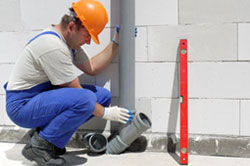The jobs in plumbing information generally held by the public is that this line of work does not involve more than unclogging a malfunctioning toilet system, repairing leaks or removing waste accumulation in the drain. However, when it comes to plumbing, this type of job is only the tip of the iceberg. In fact, there are substantially more duties that a licensed and bonded plumber performs, whether it is in the residential sector or its commercial counterpart.
To put it simply, any location that includes water or waste transportation and has associated appliances that are essential to its performance can be subjected to failures, all of which require the expertise of a plumber who can perform repairs or maintenance.
The main specializations
The second misconception the general public has bout this profession is that all plumbing specializations fall into the same category and that a licensed plumber can perform all types of repairs, installations and maintenance with only the basic training. This, however, is rarely true and in most cases plumbers choose to follow a single specialization. The most common ones are as follows:
- Traditional plumbing (can install, repair and maintain a bathtub and other appliances, waste disposal system, pipeline, and etc.)
- Pipelaying (performs trench preparations, lays the concrete clay or other adhesive substances, installs pipes for water, waste or gas)
- Pipefitting (specializes in the installation of low and high pressure pipelines, generally works in manufacturing, electrical generation or temperature control industry)
- Steamfitting (specialized in systems that involve the transportation liquid or gas at high pressures)
- Sprinklefitters (specialized in the installation of safety sprinklers to prevent fires)
More often than not, the legislation of the United States mandates that all plumbing specializations, and particularly those with hazardous jobs, need to be certified. In order to obtain the certification, plumbers are required to follow the courses of a vocational or technical school and work two to five years as apprentices under supervision.
The work environment
Typically, working as a traditional plumber involves the maintenance of plumbing systems found in residential and commercial structures. This can mean anything from repairing a leaky pipeline to installing a bathtub or a new sink. Furthermore, the plumbing job could involve the maintenance or draining of a septic tank, unclogging a drainage system, and so on, but these operations are generally performed indoors.
At the opposite end, pipelaying means working outside, in weather conditions that may not always be favorable, in order to construct pipeline systems for gas and water and their castings. Pipefitters and steamfitters can usually be found in a manufacturing or power plant, whereas sprinklefitting is required by virtually any construction that needs fire hazard protection.
The downsides
Although stress-free and quite financially rewarding, plumbing specializations have a couple of downsides. First of all, it is not uncommon for the person performing the plumbing task to work for extended periods of time in confined spaces, undertake heavy lifting or be forced to stand for a long time. At the same time, job hazards include burn risks, cuts or even falling from a high ladder.

- Home
- Jobs In Plumbing Information
- Entry Level Plumbing Jobs
- How To Bid A Plumbing Job
- Job Search Plumbing
- Jobs In Plumbing Qualifications
- Plumber Job Openings
- Plumbing Contract Work
- Plumbing Employment Agencies
- Plumbing Job Description
- Plumbing Jobs Agencies
- Plumbing Jobs Rates
- Plumbing Jobs Recruitment
- Plumbing Jobs Training
- Plumbing Jobs Websites
- Jobs In Plumbing USA
- Types Of Jobs In Plumbing
